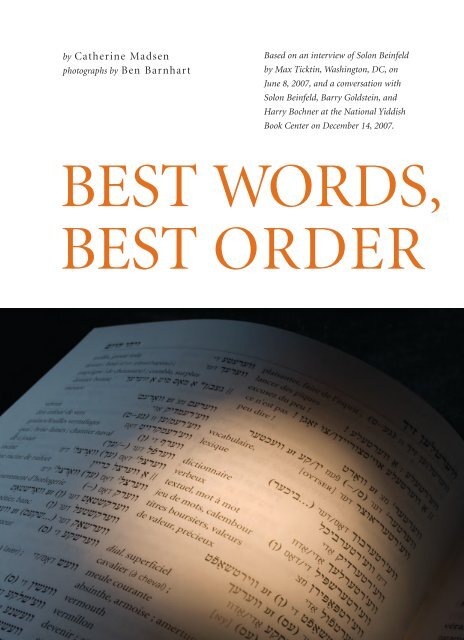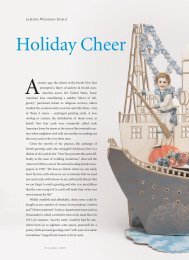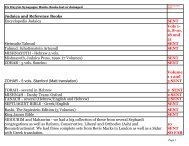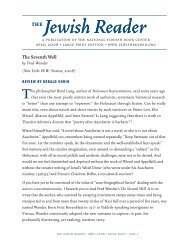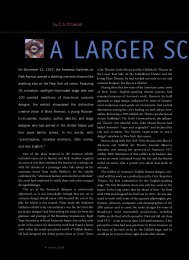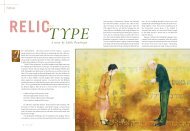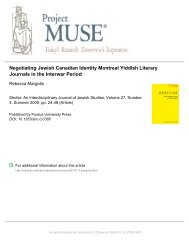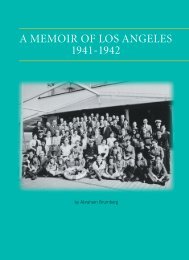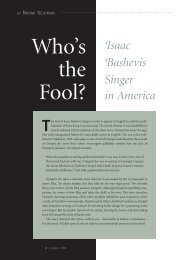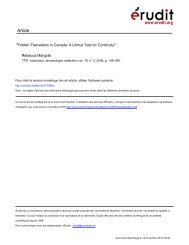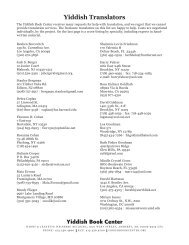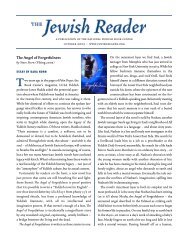by Catherine Madsen - Yiddish Book Center
by Catherine Madsen - Yiddish Book Center
by Catherine Madsen - Yiddish Book Center
You also want an ePaper? Increase the reach of your titles
YUMPU automatically turns print PDFs into web optimized ePapers that Google loves.
y <strong>Catherine</strong> <strong>Madsen</strong><br />
photographs <strong>by</strong> Ben Barnhart<br />
Based on an interview of Solon Beinfeld<br />
<strong>by</strong> Max Ticktin, Washington, DC, on<br />
June 8, 2007, and a conversation with<br />
Solon Beinfeld, Barry Goldstein, and<br />
Harry Bochner at the National <strong>Yiddish</strong><br />
<strong>Book</strong> <strong>Center</strong> on December 14, 2007.<br />
BEST WORDS,<br />
BEST ORDER
In 1908, a group of eminent <strong>Yiddish</strong>ists assembled in Czernowitz, Bukovina (then part of the Austro-Hungarian Empire, now in<br />
Ukraine) to argue about the spelling, grammar, vocabulary, status, and future of the <strong>Yiddish</strong> language. Among the items on their<br />
agenda was the production of a dictionary.<br />
A hundred years later, we are about to have the first comprehensive dictionary of modern <strong>Yiddish</strong>. Thanks to a handful of intrepid<br />
scholars and programmers, the Yidish-English verterbukh/<strong>Yiddish</strong>-English Dictionary is taking shape.<br />
Actually, the book will be a reworking of a <strong>Yiddish</strong>-French dictionary. In 2002, the Bibliothèque Medem in Paris published Yitskhok<br />
Niborski and Bernard Vaisbrot’s Yidish-Frantseyzish verterbukh/Dictionnaire <strong>Yiddish</strong>-Français, an exemplary work that was immediately<br />
adopted <strong>by</strong> English-speaking <strong>Yiddish</strong>ists as well. It listed so many words not represented in previous dictionaries that the extra step of<br />
translating from French to English was worth the trouble. Solon Beinfeld, director of the new dictionary project, aims to make that extra<br />
step unnecessary. The process of compiling the dictionary will be relatively quick: starting from Niborski’s abundant (and electronically<br />
stored!) lexical base, the time involved in producing an English version will be substantially less than starting from scratch.<br />
The story of <strong>Yiddish</strong> lexicography is complex, contentious, occasionally comic, and sometimes tragic. The first glossaries of<br />
<strong>Yiddish</strong> appeared in the 17th century, for the use of German merchants – and policemen: <strong>Yiddish</strong> words had entered the argot of the<br />
criminal underworld. Lexicography was just beginning to evolve in those days (Samuel Johnson’s English dictionary was not published<br />
till 1755), and there were wide variations among dictionaries in length, format, and purpose. Not until the end of the 19th<br />
century – <strong>by</strong> which time the first fascicles of the Oxford English Dictionary were being published – did the first major <strong>Yiddish</strong>-English<br />
dictionaries appear. They were written in New York <strong>by</strong> the great Alexander Harkavy, an immigrant from a learned Lithuanian family<br />
who also wrote a number of home-study manuals for <strong>Yiddish</strong> speakers learning English.<br />
Harkavy not only documented but championed the <strong>Yiddish</strong> language, at a time when most educated Jews were focused on the<br />
revival of Hebrew. His dictionaries were invaluable to their intended audience of immigrants and remain so for contemporary students<br />
in search of a broader <strong>Yiddish</strong> vocabulary. His entries are very brief, providing simply the <strong>Yiddish</strong>, the English, the part of speech, and<br />
sometimes an idiomatic usage. (Hakn, for example, is defined as “to cut, chop; to knock; to talk (fig.),” and hakn a morde is “to knock<br />
a person on the jaw.”) Harkavy did not supply grammatical particulars like the genders of nouns, nor the pronunciations<br />
of Hebrew and Aramaic imports, features that would be useful nowadays. But he had an eclectic sense of the<br />
Yitskhok Niborski <strong>Yiddish</strong> vocabulary, and his dictionaries are the best existing guide to actual usage in prewar <strong>Yiddish</strong> literature and<br />
and Bernard<br />
culture. His last dictionary, the trilingual 1928 <strong>Yiddish</strong>-English-Hebrew, has been reprinted twice <strong>by</strong> the YIVO Institute<br />
Vaisbrot’s 2002 and is still one of the primary <strong>Yiddish</strong> reference works.<br />
<strong>Yiddish</strong>-French<br />
But the rapid evolution of <strong>Yiddish</strong> did not stop in1928. Poets, writers, and ordinary speakers continued to push the<br />
dictionary. Right, boundaries of the language: adopting words from other languages, bending the meanings of existing words for new purposes,<br />
inventing new slang and bilingual puns. Snippets of non-Jewish dialect continued to attach themselves to adjacent<br />
Uriel Weinreich’s<br />
1968 <strong>Yiddish</strong>- <strong>Yiddish</strong> dialects; modern translators regularly consult Polish, Ukrainian or Russian dictionaries when translating as<br />
English dictionary. simple a thing as a letter. Decades of intense social and literary activity – to say nothing of the upheavals and terrible<br />
losses of a world war – worked major changes in <strong>Yiddish</strong> vocabulary and usage.<br />
Uriel Weinreich, who next took up the challenge, was more concerned to limit than to expand lexical <strong>Yiddish</strong>.<br />
His father, the linguist Max Weinreich, had founded the YIVO Institute in Vilna (now in New York) for the study and<br />
preservation of <strong>Yiddish</strong> cultural materials. Uriel Weinreich worked at Columbia University just as the field of <strong>Yiddish</strong><br />
studies was taking shape, and aimed to define the boundaries of the language. His 1968 Modern English-<strong>Yiddish</strong>,<br />
<strong>Yiddish</strong>-English Dictionary was a milestone in the establishment of correct usage. Whereas Harkavy was inclusive<br />
to the point of whimsy (among many other anglicisms, his 1928 dictionary includes sanovegon, “son of a gun”),<br />
Weinreich was austerely prescriptive, excising common German, Slavic and English imports as insufficiently authentic.<br />
He did coin words, notably for technological innovations, though not all of these have taken root in the language.<br />
His impeccable scholarship nevertheless produced a masterful dictionary, thorough<br />
and helpful in including many idioms that would otherwise confound the beginner.<br />
Tragically, Weinreich died at the age of 40, while his dictionary was still in proof.<br />
His family and friends saw it through publication under YIVO’s auspices. The book<br />
remains in print and is still indispensable for <strong>Yiddish</strong> readers at all levels, but it has<br />
never been revised. One can only wonder how Weinreich’s thinking and methods might<br />
have changed over the course of 30 or 40 more years.
Nahum Stutchkoff’s 900-page thesaurus,<br />
Der oytser fun der Yidisher<br />
shprakh (The Treasury of the <strong>Yiddish</strong><br />
Language, 1950), provides a rich supplement<br />
to the standard dictionaries.<br />
Stutchkoff was a <strong>Yiddish</strong> actor, playwright,<br />
and radio announcer noted<br />
for his eloquence who also compiled<br />
the only <strong>Yiddish</strong> rhyming dictionary.<br />
However, as generations of Englishspeaking<br />
students have found with<br />
Roget ’s, it is dangerous to try and<br />
extrapolate definition and usage from<br />
a thesaurus; the unwary writer can<br />
make really embarrassing mistakes. As<br />
Nokhem Stutchkoff’s a source of vocabulary the Oytser is<br />
Der oytser fun der splendid, but the nuances of meaning<br />
Yidisher shprakh. must be filled in from other sources.<br />
Yudl Mark, a major figure in <strong>Yiddish</strong> linguistics and education<br />
and author of the invaluable 1978 textbook Gramatik fun<br />
der Yidisher klal-shprakh (Grammar of Standard <strong>Yiddish</strong>),<br />
worked for many years on the <strong>Yiddish</strong>-<strong>Yiddish</strong> Groyser verterbukh<br />
fun der Yidisher shprakh (Great Dictionary of the <strong>Yiddish</strong><br />
Language). Four volumes, covering only the letter alef, were<br />
published between 1961 and 1980. This is a much larger<br />
achievement than English speakers might guess, since a<br />
number of common <strong>Yiddish</strong> prefixes (and the vast majority of<br />
words beginning with vowel sounds) have an initial alef :<strong>by</strong><br />
stripping away the prefixes one can identify verb roots for the<br />
whole alphabet. Fifteen or so prefixes – among them oys, oyf,<br />
on, op, arum, avek, aroyf, aroys, arayn, arop, ariber – can attach<br />
themselves to the verb geyn,“to go”; the prefixes yield various<br />
subtleties of expression, but the underlying root geyn is easy to<br />
spot. When this factor is taken into account, the four alef volumes<br />
cover about one-third of the <strong>Yiddish</strong> lexicon.<br />
Yudl Mark died in 1975. A group of his colleagues<br />
attempted to continue his work, with ambitious plans –<br />
beyond the capacity of the software then available – but did<br />
not manage to complete any subsequent volumes. The project<br />
eventually lost its funding and was never revived, again<br />
an immense loss to the <strong>Yiddish</strong> world. Rumors (and recriminations)<br />
still circulate about the failure of the project and the<br />
location and extent of the remaining materials.<br />
For many years, Mordkhe Schaechter was the man to contact<br />
for the meanings of obscure <strong>Yiddish</strong> words and for new<br />
coinages. Born in Czernowitz in 1927, he came to New York<br />
in 1951, had a long association with YIVO, and taught in the<br />
YIVO/Columbia Weinreich summer program in <strong>Yiddish</strong><br />
from its inception in 1968 until 2004. After Schaechter’s<br />
death in 2007, an obituary in the Forward described him as a<br />
“one-man Academy of the <strong>Yiddish</strong> Language.”<br />
Schaechter was fascinated <strong>by</strong> minutiae, and published a<br />
substantial list of <strong>Yiddish</strong> botanical terminology as well as a<br />
book of terms relating to pregnancy, birth, and early childhood.<br />
Among the work he left behind is an enormous card<br />
file of the sexual terminology in use among yeshiva students<br />
(needed for – among other purposes, one supposes –<br />
Talmudic debate). Schaechter was associate editor of the<br />
Groyser verterbukh in the 1980s, and not surprisingly was at<br />
work on his own dictionary. His descendants are organizing<br />
his materials into an English-<strong>Yiddish</strong> dictionary that will<br />
undoubtedly be a magnificent counterpart to Beinfeld’s<br />
<strong>Yiddish</strong>-English.<br />
Yitskhok Niborski, compiler of the <strong>Yiddish</strong>-French dictionary<br />
from which Beinfeld’s group is working, was born in<br />
1947 in Argentina – the Library of Congress lists him as<br />
Isidoro – and attended the excellent <strong>Yiddish</strong> day schools of<br />
Buenos Aires, whose students spoke <strong>Yiddish</strong> even on the<br />
playground. As an adult he taught in those same schools, and<br />
co-authored a <strong>Yiddish</strong>-Spanish, Spanish-<strong>Yiddish</strong> dictionary.<br />
Gradually it became clear that the schools were being compelled<br />
to shift from <strong>Yiddish</strong> to Hebrew education. Niborski<br />
moved to Paris to work at the Bibliothèque Medem, a vibrant<br />
center of <strong>Yiddish</strong> activity and the largest <strong>Yiddish</strong> library in<br />
Europe. His 1997 Verterbukh fun loshn-koydesh-shtamike<br />
verter in yidish (Dictionary of Words of Hebrew and Aramaic<br />
Origin in <strong>Yiddish</strong>) is an invaluable tool for decoding the often<br />
difficult Hebrew spellings and sometimes surprising <strong>Yiddish</strong><br />
usages of Hebraic elements. Niborski’s <strong>Yiddish</strong>-French dictionary<br />
contains roughly 37,000 words to Weinreich’s 20,000,<br />
restoring the German and Slavic imports and introducing<br />
many dialectal forms.<br />
Niborski’s dictionary stands in Harkavy’s descriptive tradition<br />
rather than Weinreich’s normative one. The expansion of<br />
the field of <strong>Yiddish</strong> studies since Weinreich’s time made such a<br />
dictionary imperative. Scholars from many specialties now<br />
use <strong>Yiddish</strong> books and documents in their research. Serious<br />
students and translators of <strong>Yiddish</strong> fiction and poetry have<br />
been handicapped for a long time <strong>by</strong> the lack of a dictionary<br />
that draws from the full range of post-1928 literary sources.<br />
Political and social historians of Eastern European Jewry and<br />
the Holocaust need much better access to the range of dialects<br />
represented in memoirs, personal papers, and yisker-bikher<br />
(memorial books for destroyed communities). Few of these<br />
scholars are native <strong>Yiddish</strong> speakers, and the potential for misunderstanding<br />
and mistranslation is enormous.<br />
Solon Beinfeld, who is a native <strong>Yiddish</strong> speaker as well as<br />
the son of a teacher in the Workmen’s Circle schools, is a historian<br />
of modern Europe, specializing most recently in the<br />
Holocaust in the Kovno and Vilna ghettos. Based in Boston, he<br />
has made frequent research trips to the Medem, and met<br />
Niborski there. When Niborski’s dictionary appeared, Beinfeld<br />
24 SPRING 2008
told him how deeply appreciated it was in America. It would<br />
make sense, he added, given the much wider reach of English<br />
in the Jewish world, to have an English version. (“In Israel<br />
French is not a language,” an Israeli had remarked to him.)<br />
Such a version would have to be prepared, Beinfeld continued,<br />
<strong>by</strong> a native speaker of both <strong>Yiddish</strong> and English who was also<br />
fluent in French. Niborski looked at him and said, “Nu?”<br />
Thus are vocations discovered and fates sealed. Beinfeld<br />
knew that he would need collaborators with professional linguistic<br />
expertise and high-level programming skills. From his<br />
<strong>Yiddish</strong> group in the Boston area, the Khalyastre (“the Gang,”<br />
version), more words can be added at any time, and it is theoretically<br />
possible to produce dictionaries for other languages<br />
from the same database as demand and expertise arise. The<br />
English version will appear in hard copy first – a number of<br />
university presses have expressed interest – but subsequently it<br />
will be posted in full on the Web, where it can continue to<br />
expand in cyberspace as new entries are approved.<br />
The question in everyone’s mind is, When will the dictionary<br />
appear? As always, the answer depends partly on funding.<br />
Beinfeld and other retirees are donating their time, but<br />
younger contributors are not in a position to do so. After initial<br />
named for a group of avant-garde <strong>Yiddish</strong> writers in 1920s<br />
Warsaw), he drafted linguist Harry Bochner and writer Barry<br />
Goldstein, both of whom are professional programmers.<br />
Other colleagues include Michael Rosenbush, another Medem<br />
visitor who was born in Lublin and is a retired professor of<br />
Slavic languages, and project manager Elizabeth Berman.<br />
Harry Bochner has created a clear, comprehensible format<br />
for entering definitions – no easy task when dealing with two<br />
languages that read in opposite directions. The screen displays<br />
an entry with the <strong>Yiddish</strong> word, grammatical information, the<br />
French definition, and fields for entering the English definition<br />
and any comments or questions for further consideration.<br />
Once the work of the various contributors has been combined<br />
into one file <strong>by</strong> a separate program, this program allows the<br />
editor to compare the versions, word <strong>by</strong> word, and edit them as<br />
necessary for the final version.<br />
Besides the streamlining of the compilation process, the<br />
great advantage of having the dictionary in a standard computerized<br />
form (XML, for the technically minded), is that the<br />
database is infinitely expandable. The original French information<br />
is still there (though it will not appear in the English<br />
grants from the Schaechter Foundation, Yudl Mark’s <strong>Yiddish</strong>-<br />
London <strong>Yiddish</strong>ist Hirsh Perloff, and the <strong>Yiddish</strong> Groyser<br />
Hanadiv Foundation in Britain, the project<br />
received a generous grant from the<br />
verterbukh fun der<br />
Yidisher shprakh<br />
(Great Dictionary of<br />
Forward Foundation, and most recently<br />
the <strong>Yiddish</strong> Language).<br />
the David and Barbara B. Hirschhorn<br />
Foundation has contributed. The most critical stage will be the<br />
process of reconciling and editing the final entries; this really<br />
needs to be under one person’s supervision, and will need substantial<br />
and focused blocks of time. It would be a wonderful<br />
goal to finish the work in 2008, a hundred years after the<br />
Czernowitz conference, but at present it looks as if there is<br />
more than a year’s work left.<br />
The latest news on the project can be found at www.verterbukh.org,<br />
and donations can be made at www.afmedem.org.<br />
The <strong>Yiddish</strong> world will be watching with all the solicitous<br />
care, well-meaning interference, and anxious superstition<br />
with which a family watches a long-awaited pregnancy. <br />
<strong>Catherine</strong> <strong>Madsen</strong> is a contributing editor to Pakn Treger.<br />
Her most recent book is In Medias Res: Liturgy for the Estranged.<br />
25 PAKN TREGER


